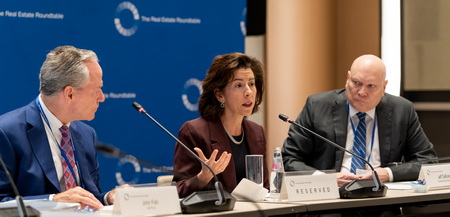
The Real Estate Roundtable’s Q3 2025 Sentiment Index shows increased confidence among industry executives as market conditions stabilize and sector-led growth emerges. The overall Index registered a score of 67—up 13 points from Q2—with notable increases in both the Current (63) and Future (71) indices. (Full Report)
Roundtable View
- RER President and CEO Jeffrey DeBoer said, “Our Q3 Sentiment Index results show that market conditions have continued to stabilize in a meaningful way, supported by improved supply and demand. Commercial real estate executives are increasingly optimistic that the next 12 months will bring continued improvement. That said, certain property types continue to face headwinds, and capital access remains uneven across markets and sectors. Even so, the prevailing sentiment is that stability is returning and opportunities are emerging.” (Press Release, Aug. 14)
- DeBoer added, “The provisions in the One Big Beautiful Bill Act should help accelerate this momentum—expanding housing supply, revitalizing communities, spurring job-creating investment nationwide, and strengthening the broader economy. Coupled with improving debt capital availability and stabilizing asset values, these policies set the stage for renewed growth. Moving forward, industry leaders and policymakers must continue to work together to promote investment, ensure credit access, and address persistent supply-demand imbalances in housing and other high-need property sectors.” (ConnectCRE, Aug. 14)
Topline Findings
The Q3 Sentiment Index topline findings include:
- The Q3 2025 Sentiment Index registered an overall score of 67, an increase of 13 points over the previous quarter. The Current Index registered a score of 63, a 13-point increase over Q2 2025. The Future Index posted a score of 71 points, an increase of 13 points over the previous quarter, reflecting sentiment that operating conditions have largely stabilized. Occupancy and demand are holding, and values appear to have bottomed. Participants expect modest, sector-led growth, yet acknowledge lingering headwinds for weaker property types.
- Sentiment around general market conditions has markedly increased since last quarter (Q2). Only 10% of respondents believe that general market conditions are worse than this time last year, and 56% of respondents believe that general market conditions are better than this time last year. Almost three-quarters (73%) of Q3 survey participants expect general market conditions to show improvement one year from now. Multifamily, data centers, and NYC office shine while industrial supply is overbuilt.
- Half of respondents believe asset values are roughly unchanged compared to a year ago. The remaining respondents are divided, with 32% believing asset prices have increased and 18% believing they have declined. Looking ahead, the outlook is optimistic: 59% expect asset prices to rise over the next year, 32% believe asset values will remain stable, and only 9% anticipate a slight decline.
- Perceptions on the availability of equity capital relative to last year are muted, with 50% of respondents believing equity availability is unchanged compared to a year ago. On the other hand, sentiment around debt capital has risen significantly, as 65% said the availability of debt capital has improved from last year. Looking forward, 55% of respondents believe that equity capital availability will be better in one year, and 48% believe debt capital availability will be better.
Market Dynamics

- Survey participants emphasized the sector-specific nature of today’s market, with performance tied closely to location, asset quality, and loan maturity schedules. Sample responses noted that conditions feel “far steadier than we have seen in recent years,” while others highlighted that “quality product will still get funded” despite a “haves and have-nots” equity environment. (ConnectCRE, Sept. 2)
- The Federal Reserve’s Beige Book released this week, noted that while overall economic momentum remains muted, commercial real estate showed resilience, especially in data center construction.
- Districts such as Philadelphia, Cleveland, and Chicago reported a surge in development, fueled by the push to deploy AI and select infrastructure projects. The Fed described this trend as a rare bright spot for CRE in an otherwise cautious market, while conditions in other property sectors varied widely. (GlobeSt. Sept. 4)
- The commercial real estate industry continues to face persistent challenges from a shortage of skilled labor and rising construction costs, underscoring the urgent need for workforce development and training initiatives.
- Labor Secretary Lori Chavez-DeRemer, joined Punchbowl News Thursday to discuss workforce innovation, calling for more apprenticeship and training programs to address the growing construction labor shortage. (Punchbowl News, Sept. 5)
RER’s Q3 survey was conducted in July by Chicago-based Ferguson Partners. Read the full Q3 report.









